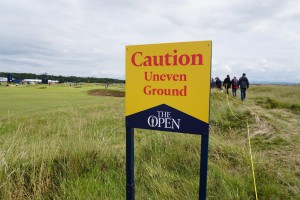Walking onto the grounds of any golf tournament is incredible. But walking onto the grounds of a major and on top of that THE OPEN is something every golfer should make a pilgrimage to.
Coming from the states and really only experiencing American golf I have to say there is something refreshing about golf in Scotland. It just feels right, authentic, honest… the way it should be.
I know you’ve probably heard something like that before. But honestly it’s incredible. If you get the chance to go… Go to THE OPEN.
I was lucky enough to make it to 3 days at THE OPEN and was able to follow around a number of players and see just about every hole on the golf course. (the highlight by far was watching Phil make eagle on 4 as I stood just off the green to the right)
Making research practical is always something we’re trying to do here at the Golf Science Lab and as I was walking the grounds of the Royal Troon I had 2 realizations that backed up some of the research and concepts we’ve been sharing lately.
#1 Caution Uneven Ground.
Golf in North America is very different than links golf… VERY different.
 A flat fairway lie to hit the ball off of?!? Good luck. It’s hard enough as a spectator to make it around the course, hitting golf balls off of all these different lies and slopes demands serious skills.
A flat fairway lie to hit the ball off of?!? Good luck. It’s hard enough as a spectator to make it around the course, hitting golf balls off of all these different lies and slopes demands serious skills.
It reminded me of a conversation with Dr. Robert Bjork talking about desirable difficulties. The concept that some challenges and difficulties pushing you beyond what your comfortable with will improve your learning… building skills that are DURABLE and FLEXIBLE.
The skill of hitting a 7 iron off of a matt on a driving range doesn’t help you play well at The Open.
As a golfer you must have skills that are adaptable to any environment that’s thrown at you. It’s looking at a problem and having the skills and ability to find the right solution for you. To do that you need a learning environment that pushes you beyond what’s comfortable and integrates appropriate levels of desirable difficulties.
THE TRUTH = It’s all about building skills that can adapt rather than golf swings that look good on the range. Function > Form.
The postage stamp really is a cool hole to watch. Just a great experience #TheOpen pic.twitter.com/ZNXcb2ur9h
— Cordie Walker (@cordiewalker) July 14, 2016
#2 Don’t expect to know where you ball is going
In the states we like flat fairways and greens so you can watch your ball bounce and pretty much have the course in front of you. At Royal Troon and links courses in general you’re finding lines over a specific hill or in some instances a building.
You simply don’t have the course set up in front of you. I also had a chance to play the Old Course at St. Andrews while visiting Scotland and was amazed at how many times I had no idea where I was hitting.
We simply had to rely on the lines the caddies shared with us. My favorite was “Just give it a hit over the L in HOTEL”.

It takes trust and commitment when you can’t see exactly where you’re headed and not really sure what kind of kick the ball is going to get when it hits the ground.
You really have to commit to your shots and understand that the results are really out of your control. You could get a kick that sends the ball directly left or right or makes it go 50 yards farther than you expect because the ball hits off of knob and kicks it forward
No one can deny that both Phil Mickelson and Henrik Stenson were in the ZONE. If you want to know exactly what that means definitely listen into this past episode with Dr. Michael Lardon who in fact is Phil’s psychologist.
They talk about developing a “mental scorecard” model. It satiates that primal need to rate yourself, to judge yourself, but it does it in the way that you have the capacity to be in 100% control of it.
You score yourself on those three phases for every shot you hit during a round, and you end up with a percentage that represents your mental score. If you play a par-4 and make bogey, 5 is your physical score. But if you successfully go through the three phases of your routine for each of the five shots, your mental score is 5/5, or 100 percent.
The top Tour players in the world routinely score in the high 90s. The difference between winning a major and keeping your card is about 7 or 8 percentage points—five or six shots per round with less than full concentration. The club champion at your course would probably score in the high 60s or low 70s.
THE TRUTH = You only control your commitment to the process. The results are out of your control.
Making the trip to THE OPEN was truly magical.
If you can make the trip… DO IT. You won’t regret it.
AMAZING week at #thopen doesn’t get any better than this. Huge thanks @tomstickneygolf & @WilliamMcGirt for the tix pic.twitter.com/ZWQZDULxRk
— Cordie Walker (@cordiewalker) July 17, 2016



